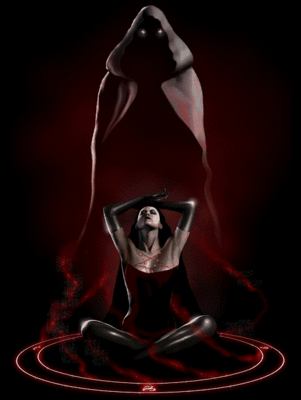Spellcraft
19:20 Jan 21 2016
Times Read: 416
Witchcraft broadly means the practice of, and belief in, magical skills and abilities that are able to be exercised individually by designated social groups, or by persons with the necessary esoteric secret knowledge. Witchcraft is a complex concept that varies culturally and societally; therefore, it is difficult to define with precision and cross-cultural assumptions about the meaning or significance of the term should be applied with caution. Witchcraft often occupies a religious, divinatory or medicinal role, and is often present within societies and groups whose cultural framework includes a magical world view. Although witchcraft can often share common ground with related concepts such as sorcery, the paranormal, magic, superstition, necromancy, possession, shamanism, healing, spiritualism, nature worship and the occult, it is usually seen as distinct from these when examined by sociologists and anthropologists.
The concept of witchcraft and the belief in its existence have existed throughout recorded history. They have been present or central at various times, and in many diverse forms, among cultures and religions worldwide, including both "primitive" and "highly advanced" cultures, and continue to have an important role in many cultures today. Scientifically, the existence of magical powers and witchcraft are generally believed to lack credence and to be unsupported by high quality experimental testing, although individual witchcraft practices and effects may be open to scientific explanation or explained via mentalism and psychology.
Historically, the predominant concept of witchcraft in the Western world derives from Old Testament laws against witchcraft, and entered the mainstream when belief in witchcraft gained Church approval in the Early Modern Period. It posits a theosophical conflict between good and evil, where witchcraft was generally evil and often associated with the Devil and Devil worship. This culminated in deaths, torture and scapegoating (casting blame for human misfortune), and many years of large scale witch-trials and witch hunts, especially in Protestant Europe, before largely ceasing during the European Age of Enlightenment. Christian views in the modern day are diverse and cover the gamut of views from intense belief and opposition (especially from Christian fundamentalists) to non-belief, and in some churches even approval. From the mid-20th century, witchcraft – sometimes called contemporary witchcraft to clearly distinguish it from older beliefs – became the name of a branch of modern paganism. It is most notably practiced in the Wiccan and modern witchcraft traditions, and no longer practices in secrecy.
The Western mainstream Christian view is far from the only societal perspective about witchcraft. Many cultures worldwide continue to have widespread practices and cultural beliefs that are loosely translated into English as "witchcraft", although the English translation masks a very great diversity in their forms, magical beliefs, practices, and place in their societies. During the Age of Colonialism, many cultures across the globe were exposed to the modern Western world via colonialism, usually accompanied and often preceded by intensive Christian missionary activity. Beliefs related to witchcraft and magic in these cultures were at times influenced by the prevailing Western concepts. Witch hunts, scapegoating, and killing or shunning of suspected witches still occurs in the modern era, with killings both of victims for their supposedly magical body parts, and of suspected witchcraft practitioners.
Suspicion of modern medicine due to beliefs about illness being due to witchcraft also continues in many countries to this day, with tragic healthcare consequences. HIV/AIDS and Ebola virus disease are two examples of often-lethal infectious disease epidemics whose medical care and containment has been severely hampered by regional beliefs in witchcraft. Other severe medical conditions whose treatment is hampered in this way include tuberculosis, leprosy, epilepsy and the common severe bacterial Buruli ulcer. Public healthcare often requires considerable education work related to epidemology and modern health knowledge in many parts of the world where belief in witchcraft prevails, to encourage effective preventive health measures and treatments, to reduce victim blaming, shunning and stigmatization, and to prevent the killing of people and endangering of animal species for body parts believed to convey magical abilities.
Witchcraft originated with the human civilization itself. The fear of the unknown and its imagined role in making our day to day life easy or difficult, created witches and their craft. Even though witchcraft as such was practiced mainly by experienced and old women, men also practiced it. Witches were the mediators between the human beings and the mysterious super powers such as spirits and angels. When a witch succeeded in resolving the apparently mysterious problem of someone, the performance was termed as magic, a process that could not be easily explained away through any logical analysis. The witches prayed to the higher powers or the spirits for help and guidance in resolving the problem by performing certain rituals and the whole process was called witchcraft.
Witchcraft, an earth based religion, was practiced in almost all the societies and cultures across the world according to local beliefs and traditions.
According to scholars of witchcraft, it was a belief system whose origin predates the majority of well known religions on this earth. It dates 40,000 years back to Paleolithic period. It has been evolving since then and its present form is quite different from what it was a thousand or five thousand years back. It did not probably have this name as well. Even different covens perform the witchcraft differently.
Archeological discoveries have revealed that people worshipped hunter god and fertility goddess during the Paleolithic period. This has been proved by the discovery of cave paintings which are estimated to be 30,000 years old. There is a painting that depicts a man with the head of a stag. In yet another painting, there is a pregnant woman standing in a circle with eleven other people. These relics go to prove that witchcraft is one of the oldest religions in the world. Wiccan view of God and Goddess aspect of the supreme creative force predates thousands of years before Christianity.
In the ancient times, Witchcraft was known as ‘craft of the wise’ as the wise persons were those who followed the path of nature and were in tune with its forces, had the knowledge of herbs and medicines, gave wise counsel and were held in high esteem as Shamanic healers and leaders in the village and community. They understood that nature was superior to human beings and that human beings were simply one of the many parts of nature, both seen and unseen that combine to form one whole. As Chief Seattle said, “We do not own the earth; we are a part of it.” They understood that what we take from nature or use, we must return in kind to maintain the balance and equilibrium. The modern man has, however, forgotten this and has paid the price in form of many ecological and environmental disasters.







COMMENTS
-